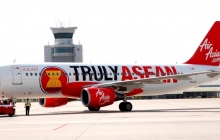AirAsia was launched in 2001 with the dream of making flying possible for everyone. Since then, AirAsia has swiftly risen to become the world’s best...
-

Automotive
Where to invest?
Automotives
The auto industry in ASEAN has exhibited strong growth over the last few years.
Combined motor vehicle sales in 6 major ASEAN countries (Indonesia, Malaysia, Thailand, Philippines, Viet Nam, and Singapore) reached an all time high of 3.5 million units in 2012, almost double of sales figures in 2007 which is 1.9 million units. Sale of motor bikes and scooters also jumped 44% from 7.3 million units in 2007 to 10.5 million units in 2012.
Production of motor vehicles rose 41.5% year-on-year between 2011 and 2012. In a period of 6 years, production grew by 98% to 4.24 million units in 2012 from 2.14 million units in 2007.
Vast opportunities
ASEAN offers vast opportunities for manufacturers and distributors of automotive and vehicle components. Possibilities abound as the region’s economy remains strong and the number of middle-class households with high net disposable income increases.
Success stories in the industry’s production and sales figures are likely to continue given expected increase in demand for cars and other motor vehicles. In the entire region, ratio of person and vehicle is only at 72 per 1,000 people as of 2011. Density is highest in Malaysia at 672 per 1,000 people and lowest at 17 per 1,000 in Cambodia and Viet Nam. As ASEAN pushes for better infrastructure and improved road network across ASEAN countries, the advantages of private vehicles can be more pronounced.
ASEAN’s attractiveness for auto businesses is bolstered by the sound investment policy for the auto industry, competitive labour costs offered by ASEAN countries such as Viet Nam and the Philippines, and the availability of huge number of auto components manufacturers and strong engineering support, especially in Thailand and Malaysia.
Trade liberalisation offers industry players ease in moving motor vehicles and auto components. Under several ASEAN free trade agreements, the region has reduced/ eliminated tariff for motor vehicles from countries within ASEAN and FTA partner-countries. Non-trade barriers are also being addressed. Investors could maximise FTA benefits by opting to use manufacturing hubs in low-wage ASEAN countries to service overseas market, or by operating as part of an integrated regional or global auto supply chain while based in a highly-developed ASEAN economy.
The future of automotive industry
Analysts project the future of ASEAN auto industry and share the following figures.
- Deutsche Bank reports that car ownership in ASEAN will rise to nearly 40 million by 2015 and around 55 million by 2050
- The bank believes growth in car sales will be over 10% in average in the coming years
- Young ASEAN countries like Cambodia and Laos could achieve higher than average growth rates in vehicle sales (but volume is still less compared to other ASEAN countries)
- Business consulting firm Frost & Sullivan says that ASEAN will become the 6th biggest automotive market globally by 2018
Frost & Sullivan opines that peoples of ASEAN, especially those in Indonesia will drive local demand given shift of ownership from motor bikes to cars, multi-purpose vehicles, and sport-utility vehicles.
-
ASEAN is resolved to help investors maximize their gains from the regional integrated supply chain. Automotive, electronics, textile, logistics - four of ASEAN’s Priority Integration Sectors - drive the flow of production inputs across the regions, contributing not only to ASEAN’s growth but to the region’s industry complementation and economic integration.
SUCCESS STORIES
-
- Site Map
- Terms & Abbreviations

